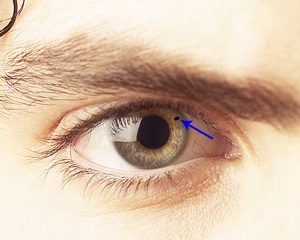66 Pacific Hwy
ST LEONARDS NSW 2065
Fax: 02-8412 0060

Laser Iridotomy is a surgical incision into the iris. The iris is a coloured ring in the eye, with the pupil at its centre. The surgeon makes a small opening in the iris to relieve abnormally high pressure of fluid inside the eyeball (angle-closure glaucoma), which would otherwise result in disturbances of vision and blindness.
Normally the fluid inside the eyeball flows in and out of the eye through a thin strip of stiff tissue (trabecular meshwork). When the fluid cannot drain through this stiff tissue the pressure inside the eye may rise and could damage the optic nerve, which leads to vision loss.
Also the iris may be pushed forward due to the increased eye pressure and block the drainage system completely. This may result in an angle-closure glaucoma attack, which is a medical emergency.
If the fluid that drains from the eye is completely blocked, a laser iridotomy is necessary to create new routes for fluid to flow from behind the iris to the outflow drain of the eye.
Regular eye exams help to detect an eye at risk for angle-closure glaucoma. Your ophthalmologist uses a mirrored lens to see if the trabecular meshwork is in danger of being blocked. Eyes at risk for angle-closure glaucoma may have laser iridotomy as a preventive treatment.
People at higher risk of developing angle-closure glaucoma are people of Asian or Eskimo ancestry. Also if angle-closure glaucoma has been in your family history there might be a higher risk, and women are at higher risk than men.
When angle-closure glaucoma develops slowly, there are no obvious symptoms, which means that not all people with angle-closure glaucoma experience an attack. Your doctor can recognize a risk for angle-closure glaucoma before you experience any symptoms.
If you experience an attack the symptoms are:
Permanent vision loss may occur, if the pressure is not relieved within a few hours.
In a laser iridotomy operation your eye surgeon will give you eye drops to numb your eye. A contact lens will be placed on your eye to precisely focus the laser. The operation takes only a few minutes and you may feel a pinch-like sensation and you may also see a bright light like a photographer’s flash. You may go on with your regular activities after the treatment but it is advisable to have someone drive you home.
The opening made by an iridotomy will remain a scar the size of a pinhead. Usually neither you nor your friends will notice it. It is usually located in the upper part of the iris, which is covered by your upper eyelid.
The main risks of laser procedure are:
Loss of vision after laser iridotomy is rare.
Regular eye examination and early detection and treatment of glaucoma offer the best chance of preserving your vision. Laser iridotomy is a safe and effective procedure with few risks but it cannot restore vision already lost from glaucoma.














